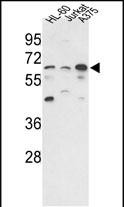PPP3CC Antibody (N-term)
Purified Rabbit Polyclonal Antibody (Pab)
- SPECIFICATION
- CITATIONS
- PROTOCOLS
- BACKGROUND

Application
| IHC-P, WB, E |
|---|---|
| Primary Accession | P48454 |
| Other Accession | PPP3CC |
| Reactivity | Human |
| Host | Rabbit |
| Clonality | Polyclonal |
| Isotype | Rabbit IgG |
| Calculated MW | 58129 Da |
| Antigen Region | 18-47 aa |
| Gene ID | 5533 |
|---|---|
| Other Names | Serine/threonine-protein phosphatase 2B catalytic subunit gamma isoform, CAM-PRP catalytic subunit, Calcineurin, testis-specific catalytic subunit, Calmodulin-dependent calcineurin A subunit gamma isoform, PPP3CC, CALNA3, CNA3 |
| Target/Specificity | This PPP3CC antibody is generated from rabbits immunized with a KLH conjugated synthetic peptide between 18-47 amino acids from the N-terminal region of human PPP3CC. |
| Dilution | IHC-P~~1:50~100 WB~~1:1000 E~~Use at an assay dependent concentration. |
| Format | Purified polyclonal antibody supplied in PBS with 0.09% (W/V) sodium azide. This antibody is prepared by Saturated Ammonium Sulfate (SAS) precipitation followed by dialysis against PBS. |
| Storage | Maintain refrigerated at 2-8°C for up to 2 weeks. For long term storage store at -20°C in small aliquots to prevent freeze-thaw cycles. |
| Precautions | PPP3CC Antibody (N-term) is for research use only and not for use in diagnostic or therapeutic procedures. |
| Name | PPP3CC |
|---|---|
| Synonyms | CALNA3, CNA3 |
| Function | Calcium-dependent, calmodulin-stimulated protein phosphatase which plays an essential role in the transduction of intracellular Ca(2+)-mediated signals. Dephosphorylates and activates transcription factor NFATC1. Dephosphorylates and inactivates transcription factor ELK1. Dephosphorylates DARPP32. |
| Cellular Location | Mitochondrion {ECO:0000250|UniProtKB:P48455}. Note=Localizes in the mitochondria in a SPATA33-dependent manner {ECO:0000250|UniProtKB:P48455} |
| Tissue Location | Testis.. |

Thousands of laboratories across the world have published research that depended on the performance of antibodies from Abcepta to advance their research. Check out links to articles that cite our products in major peer-reviewed journals, organized by research category.
info@abcepta.com, and receive a free "I Love Antibodies" mug.
Provided below are standard protocols that you may find useful for product applications.
Background
Calmodulin-dependent protein phosphatase, calcineurin, is involved in a wide range of biologic activities, acting as a Ca(2+)-dependent modifier of phosphorylation status. In testis, the motility of the sperm is thought to be controlled by cAMP-dependent phosphorylation and a unique form of calcineurin appears to be associated with the flagellum. The calcineurin holoenzyme is composed of catalytic and regulatory subunits of 60 and 18 kD, respectively. At least 3 genes, calcineurin A-alpha, calcineurin A-beta, and calcineurin A-gamma (CALNA3), have been cloned for the catalytic subunit. These genes have been identified in humans, mice, and rats, and are highly conserved between species (90 to 95% amino acid identity).
References
Eastwood, S.L., et al., Biol. Psychiatry 57(7):702-710 (2005).
Gerber, D.J., et al., Proc. Natl. Acad. Sci. U.S.A. 100(15):8993-8998 (2003).
Bennasser, Y., et al., Virology 303(1):174-180 (2002).
Esau, C., et al., J. Exp. Med. 194(10):1449-1459 (2001).
Muramatsu, T., et al., Biochem. Biophys. Res. Commun. 188(1):265-271 (1992).
If you have used an Abcepta product and would like to share how it has performed, please click on the "Submit Review" button and provide the requested information. Our staff will examine and post your review and contact you if needed.
If you have any additional inquiries please email technical services at tech@abcepta.com.













 Foundational characteristics of cancer include proliferation, angiogenesis, migration, evasion of apoptosis, and cellular immortality. Find key markers for these cellular processes and antibodies to detect them.
Foundational characteristics of cancer include proliferation, angiogenesis, migration, evasion of apoptosis, and cellular immortality. Find key markers for these cellular processes and antibodies to detect them. The SUMOplot™ Analysis Program predicts and scores sumoylation sites in your protein. SUMOylation is a post-translational modification involved in various cellular processes, such as nuclear-cytosolic transport, transcriptional regulation, apoptosis, protein stability, response to stress, and progression through the cell cycle.
The SUMOplot™ Analysis Program predicts and scores sumoylation sites in your protein. SUMOylation is a post-translational modification involved in various cellular processes, such as nuclear-cytosolic transport, transcriptional regulation, apoptosis, protein stability, response to stress, and progression through the cell cycle. The Autophagy Receptor Motif Plotter predicts and scores autophagy receptor binding sites in your protein. Identifying proteins connected to this pathway is critical to understanding the role of autophagy in physiological as well as pathological processes such as development, differentiation, neurodegenerative diseases, stress, infection, and cancer.
The Autophagy Receptor Motif Plotter predicts and scores autophagy receptor binding sites in your protein. Identifying proteins connected to this pathway is critical to understanding the role of autophagy in physiological as well as pathological processes such as development, differentiation, neurodegenerative diseases, stress, infection, and cancer.



